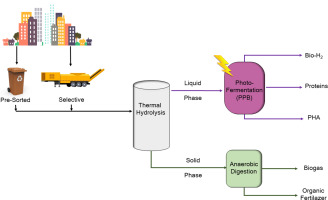当前位置:
X-MOL 学术
›
Sci. Total Environ.
›
论文详情
Our official English website, www.x-mol.net, welcomes your
feedback! (Note: you will need to create a separate account there.)
Novel approach for the treatment of the organic fraction of municipal solid waste: Coupling thermal hydrolysis with anaerobic digestion and photo-fermentation.
Science of the Total Environment ( IF 8.2 ) Pub Date : 2020-01-22 , DOI: 10.1016/j.scitotenv.2020.136845 Luis D Allegue 1 , Daniel Puyol 1 , Juan Antonio Melero 1
Science of the Total Environment ( IF 8.2 ) Pub Date : 2020-01-22 , DOI: 10.1016/j.scitotenv.2020.136845 Luis D Allegue 1 , Daniel Puyol 1 , Juan Antonio Melero 1
Affiliation

|
In this study, two different organic fractions of municipal solid waste (OFMSW) served as raw material in a novel treatment process that combines thermal hydrolysis (TH) pretreatment at different times, followed by anaerobic digestion of the solid fraction and photo-fermentation of the liquid fraction. The results indicate that both wastes performed similarly, and no statistically relevant differences stand out on the overall performance regarding TH times. The thermal pretreatment improves the biodegradability of the solid fraction during anaerobic digestion compensating the loss of the organic matter in the liquid fraction. The produced biogas may feed a combined heat and power (CHP) system, making the process energetically positive in all studied scenarios. In addition, the combination of TH and anaerobic digestion decreased the volume of the waste to be disposed by 59-61%, which is 5-11% higher than that obtained with the traditional treatment of anaerobic digestion process. Specific phototrophic activity tests were performed on the liquid phase using a mixed culture of purple phototrophic bacteria (PPB) that consumed up to 80% of the soluble organics. The assays yielded an average 52% efficiency on specific phototrophic activity (kM) and 62% on biomass yield (YX/S), compared to an optimized growth medium. PPB was also capable of producing polyhydroxyalkanoates, bioH2 and single-cell protein without optimization. Apart from methane, the overall mass balances showed yields up to 150 g of high added-value products per Kg of initial total solids on this proof-of-concept platform.
中文翻译:

处理城市生活垃圾中有机物的新方法:将热水解与厌氧消化和光发酵耦合。
在这项研究中,两种不同的城市固体废物有机组分(OFMSW)在一种新颖的处理过程中用作原料,该过程结合了在不同时间进行的热水解(TH)预处理,然后对固体部分进行厌氧消化并对其进行光发酵。液体部分。结果表明,两种废物的表现相似,在TH时间的总体表现上没有统计学上的显着差异。热预处理提高了厌氧消化过程中固体馏分的生物降解性,从而补偿了液体馏分中有机物的损失。产生的沼气可以供入热电联产(CHP)系统,使该过程在所有已研究的情景中都具有积极意义。此外,TH与厌氧消化相结合,减少了废物处理量59-61%,比传统的厌氧消化处理方法提高了5-11%。使用紫色光养细菌(PPB)的混合培养物在液相上进行了特定的光养活性测试,该细菌消耗了多达80%的可溶性有机物。与优化的生长培养基相比,该试验的比光养活度(kM)平均效率为52%,生物量产率为62%(YX / S)。PPB无需优化即可生产聚羟基链烷酸酯,bioH2和单细胞蛋白。除了甲烷以外,在该概念验证平台上,总质量平衡表明,每公斤初始总固体可生产150克高附加值产品。与传统的厌氧消化工艺相比,提高了5-11%。使用紫色光养细菌(PPB)的混合培养物在液相上进行了特定的光养活性测试,该细菌消耗了多达80%的可溶性有机物。与优化的生长培养基相比,该试验的比光养活度(kM)平均效率为52%,生物量产率为62%(YX / S)。PPB无需优化即可生产聚羟基链烷酸酯,bioH2和单细胞蛋白。除了甲烷以外,在该概念验证平台上,总质量平衡表明,每公斤初始总固体可生产150克高附加值产品。与传统的厌氧消化工艺相比,提高了5-11%。使用紫色光养细菌(PPB)的混合培养物在液相上进行了特定的光养活性测试,该细菌消耗了多达80%的可溶性有机物。与优化的生长培养基相比,该试验的比光养活度(kM)平均效率为52%,生物量产率为62%(YX / S)。PPB无需优化即可生产聚羟基链烷酸酯,bioH2和单细胞蛋白。除了甲烷以外,在该概念验证平台上,总质量平衡表明,每公斤初始总固体可生产150克高附加值产品。使用紫色光养细菌(PPB)的混合培养物在液相上进行了特定的光养活性测试,该细菌消耗了多达80%的可溶性有机物。与优化的生长培养基相比,该试验的比光养活度(kM)平均效率为52%,生物量产率为62%(YX / S)。PPB无需优化即可生产聚羟基链烷酸酯,bioH2和单细胞蛋白。除了甲烷以外,在该概念验证平台上,总质量平衡表明,每公斤初始总固体可生产150克高附加值产品。使用紫色光养细菌(PPB)的混合培养物在液相上进行了特定的光养活性测试,该细菌消耗了多达80%的可溶性有机物。与优化的生长培养基相比,该试验的比光养活度(kM)平均效率为52%,生物量产率为62%(YX / S)。PPB无需优化即可生产聚羟基链烷酸酯,bioH2和单细胞蛋白。除了甲烷以外,在该概念验证平台上,总质量平衡表明,每公斤初始总固体可生产150克高附加值产品。与优化的生长培养基相比,该试验的比光养活度(kM)平均效率为52%,生物量产率为62%(YX / S)。PPB无需优化即可生产聚羟基链烷酸酯,bioH2和单细胞蛋白。除了甲烷以外,在该概念验证平台上,总质量平衡表明每千克初始总固体可生产150克高附加值产品。与优化的生长培养基相比,该试验的比光养活度(kM)平均效率为52%,生物量产率为62%(YX / S)。PPB无需优化即可生产聚羟基链烷酸酯,bioH2和单细胞蛋白。除了甲烷以外,在该概念验证平台上,总质量平衡表明,每公斤初始总固体可生产150克高附加值产品。
更新日期:2020-01-22
中文翻译:

处理城市生活垃圾中有机物的新方法:将热水解与厌氧消化和光发酵耦合。
在这项研究中,两种不同的城市固体废物有机组分(OFMSW)在一种新颖的处理过程中用作原料,该过程结合了在不同时间进行的热水解(TH)预处理,然后对固体部分进行厌氧消化并对其进行光发酵。液体部分。结果表明,两种废物的表现相似,在TH时间的总体表现上没有统计学上的显着差异。热预处理提高了厌氧消化过程中固体馏分的生物降解性,从而补偿了液体馏分中有机物的损失。产生的沼气可以供入热电联产(CHP)系统,使该过程在所有已研究的情景中都具有积极意义。此外,TH与厌氧消化相结合,减少了废物处理量59-61%,比传统的厌氧消化处理方法提高了5-11%。使用紫色光养细菌(PPB)的混合培养物在液相上进行了特定的光养活性测试,该细菌消耗了多达80%的可溶性有机物。与优化的生长培养基相比,该试验的比光养活度(kM)平均效率为52%,生物量产率为62%(YX / S)。PPB无需优化即可生产聚羟基链烷酸酯,bioH2和单细胞蛋白。除了甲烷以外,在该概念验证平台上,总质量平衡表明,每公斤初始总固体可生产150克高附加值产品。与传统的厌氧消化工艺相比,提高了5-11%。使用紫色光养细菌(PPB)的混合培养物在液相上进行了特定的光养活性测试,该细菌消耗了多达80%的可溶性有机物。与优化的生长培养基相比,该试验的比光养活度(kM)平均效率为52%,生物量产率为62%(YX / S)。PPB无需优化即可生产聚羟基链烷酸酯,bioH2和单细胞蛋白。除了甲烷以外,在该概念验证平台上,总质量平衡表明,每公斤初始总固体可生产150克高附加值产品。与传统的厌氧消化工艺相比,提高了5-11%。使用紫色光养细菌(PPB)的混合培养物在液相上进行了特定的光养活性测试,该细菌消耗了多达80%的可溶性有机物。与优化的生长培养基相比,该试验的比光养活度(kM)平均效率为52%,生物量产率为62%(YX / S)。PPB无需优化即可生产聚羟基链烷酸酯,bioH2和单细胞蛋白。除了甲烷以外,在该概念验证平台上,总质量平衡表明,每公斤初始总固体可生产150克高附加值产品。使用紫色光养细菌(PPB)的混合培养物在液相上进行了特定的光养活性测试,该细菌消耗了多达80%的可溶性有机物。与优化的生长培养基相比,该试验的比光养活度(kM)平均效率为52%,生物量产率为62%(YX / S)。PPB无需优化即可生产聚羟基链烷酸酯,bioH2和单细胞蛋白。除了甲烷以外,在该概念验证平台上,总质量平衡表明,每公斤初始总固体可生产150克高附加值产品。使用紫色光养细菌(PPB)的混合培养物在液相上进行了特定的光养活性测试,该细菌消耗了多达80%的可溶性有机物。与优化的生长培养基相比,该试验的比光养活度(kM)平均效率为52%,生物量产率为62%(YX / S)。PPB无需优化即可生产聚羟基链烷酸酯,bioH2和单细胞蛋白。除了甲烷以外,在该概念验证平台上,总质量平衡表明,每公斤初始总固体可生产150克高附加值产品。与优化的生长培养基相比,该试验的比光养活度(kM)平均效率为52%,生物量产率为62%(YX / S)。PPB无需优化即可生产聚羟基链烷酸酯,bioH2和单细胞蛋白。除了甲烷以外,在该概念验证平台上,总质量平衡表明每千克初始总固体可生产150克高附加值产品。与优化的生长培养基相比,该试验的比光养活度(kM)平均效率为52%,生物量产率为62%(YX / S)。PPB无需优化即可生产聚羟基链烷酸酯,bioH2和单细胞蛋白。除了甲烷以外,在该概念验证平台上,总质量平衡表明,每公斤初始总固体可生产150克高附加值产品。











































 京公网安备 11010802027423号
京公网安备 11010802027423号